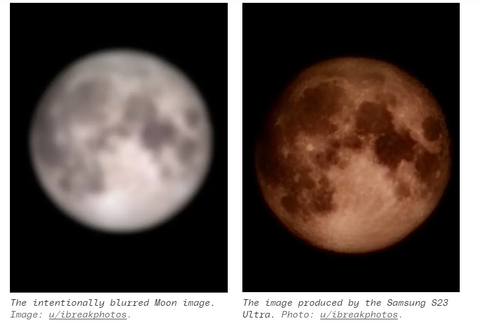Samsung's Galaxy S23 moon photo fiasco

Recently, the internet has been awash with stories about Samsung, specifically the debacle surrounding the moon photography features of the company's Samsung Galaxy S23 Ultra. The hype and contention around the company's Galaxy S23 Ultra's Space Zoom feature have caused a lot of controversies online. The feature allows users to take more detailed and zoomed-in pictures of the Moon, but a Reddit user recently accused Samsung of faking the photos. Samsung has since responded to the accusations, claiming that they do not impose any image overlaying and that the photos are authentic.

However, the controversy has raised questions about the authenticity of the photos, as well as the overall implications of the technology on the industry. This suggests that the technology is not as advanced as it may seem and that it is not capable of capturing the same level of detail as a professional camera as previously claimed.
The scandal has also called into question the ethical issues associated with using technology to manipulate images. Although Samsung has dismissed the accusations that its latest flagship was faking its moon photos, the implications of the technology are still being discussed and the conversation is bound to continue online for a while.
Ultimately, the controversy surrounding Samsung's Galaxy S23 Ultra's Space Zoom feature has raised important questions about the authenticity of images, the implications of the technology, and the ethics of using technology to manipulate images.
At the center of the controversy is the allegation that the Samsung Galaxy S23 Ultra phone is using AI to "fake" its moon photos, as the phone is able to capture crisp, detailed images of the moon that are seemingly too good to be true. This has raised questions about the accuracy of photos taken with smartphones, and whether or not AI is being used to manipulate images.
Although the discussion was initially limited to the company's moon photos, it has since grown to cover the implications of AI on mobile photography, allowing users to take stunning images without having to understand the complexities of photography. AI-powered tools can be used for color grading, composition assistance, and beautifying images. The technology can also be used to generate AI images and share them on social media. Additionally, AI can be used to take a photographer's own photographs and upload them as inspiration for the AI system to generate new images based on keywords and text prompts.
Going forward, the increased use of AI in mobile photography is bound to change the industry as we know it. On one hand, this technology can make photography more accessible and personalized to all kinds of users. On the other hand, it can blur the line between real and machine-generated pictures, making it difficult to differentiate between genuine images and AI-generated images. Furthermore, AI could potentially reduce the need for professional photographers, as it can create images that are just as good as those taken by a human.
The controversy surrounding the Galaxy S23 Ultra's moon photography has also sparked a conversation about transparency in the phone photography industry. Consumers should be aware of the capabilities of their phones and the potential for AI to be used to manipulate images. Companies should also be open about the technology they are using and how it affects the quality of photos taken with their phones. Ultimately, the Galaxy S23 Ultra's moon photo mess serves as a reminder that AI is here to stay and is becoming an integral part of our lives. For now, there is the option to turn off by deactivating the scene optimization feature.
As always, we love to hear from you and keep you in the loop with what's happening in the tech sphere. If you want to be part of the most exciting tech space on the internet, don’t forget to join our Heyup community.

